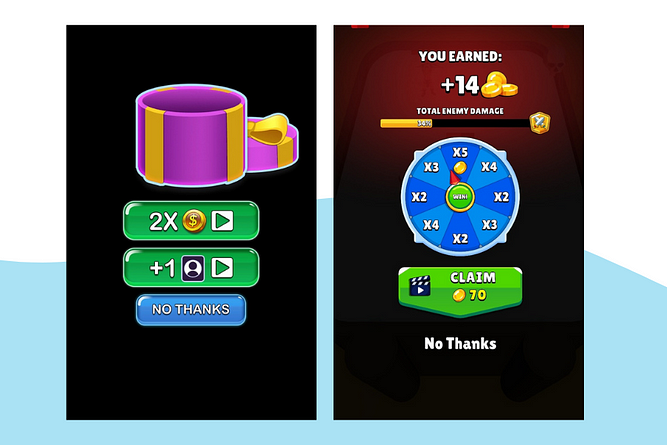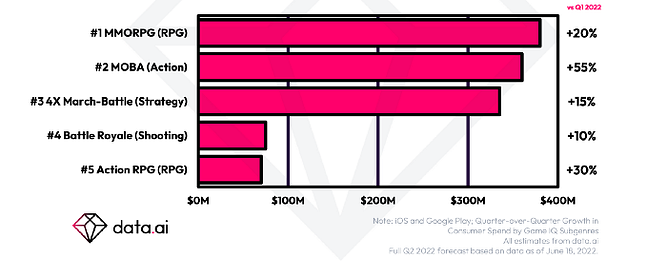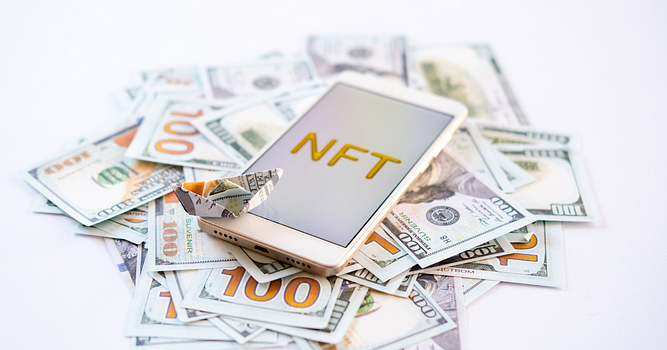Top App Monetization Trends to Be Aware of in 2023

The Arcade Idle Genre Grew by 2050% — Here’s How
November 1, 2022
Mobile Marketing for Gen Z: The Only Guide You Need
November 1, 2022The mobile ecosystem moves incredibly fast.
Some app monetization trends from just a year ago may already be outdated and ineffective. On the other hand, some come and persist for years.
But how do you keep up?
By listening to what the market is telling you. The state of the app market is merely a reflection of the global economy and social trends.
To help you stay on top of things, we’ve listed the main app monetization trends you need to know as 2023 draws near!
Apps Need to Adapt to Inflation

With global inflation raging, we can’t talk about app monetization trends the same way we did before.
We’re living in one of the worst inflation booming periods, and this is heavily affecting app users’ purchasing power. In H1 2022 alone, U.S. year-over-year game revenues dropped by almost 10%.
This is the first time something like this has happened.
Prior to the inflation boom, the mobile gaming market has been on a steady, constant rise.
Obviously, it’s not just mobile games that are taking a hit.
Inflation has and will have an even stronger effect on all forms of entertainment. This includes all sorts of app types. The reason is pretty simple — paying for entertainment is a form of luxury, not a necessity.
And when you lack money, you cut luxury first.
Due to all this, it’s necessary to adjust your app monetization strategy accordingly. Keep reading to find out the best ways to do so!
The Subscription Trend Isn’t Going Away, But…
Over the last couple of years, subscriptions have been one of the top app monetization trends.
The subscription economy has been growing before the pandemic, but the pandemic took it to new heights. The global subscription consumer spending in the top 100 apps grew sharply by 34% from 2019 to 2020 (Sensor Tower).
Soon after, numerous app developers embraced subscriptions and incorporated them into their apps.
This has led to some new, more specific trends. For example, many casual mobile games started implementing “battle pass” features. Previously, this type of subscription usually appeared in shooters and fighting console games.
Everyone predicted the further rise of subscriptions, but then — inflation happened.
Because of inflation, users are starting to cut down on subscriptions they piled up during the pandemic. This is especially true for younger generations. According to NYU research, over a third of Gen Z and Millenials are eliminating their monthly subscriptions.
Does this mean you should remove the subscription option from your app?
No, but you should adapt.
Subscriptions are definitely worth keeping. They are a steady revenue stream, they attract a loyal user base, boost retention and bring many other benefits.

Equally important — people are used to them. All the entertainment giants like Netflix, Youtube, and Spotify use this model, and the users find it convenient.
However, in the upcoming period, you can expect fewer subscribers. For this reason, it would be good to back down from a subscription-only model. For example, if your app is a fitness or a photo editing app that lives off of subscriptions, you might want to consider adding some types of in-app advertising.
Mixing Monetization Models
Due to reduced user purchasing power, you can expect a smaller amount of in-app transactions than before.
Besides subscriptions, this also includes in-app purchases.
For this reason, hybrid monetization will remain one of the biggest app monetization trends in 2023 and beyond.
To define, this term describes a mix of different monetization models within a single app. For example, an app can monetize with in-app purchases, in-app ads, and subscriptions at the same time.
The point of this?
Making the most out of each.
The main benefit of hybrid monetization is being able to make money off a wide range of users. This way, your app’s revenues are not dependent on a single group of users. For example, ad viewers or buyers only.
This approach is gaining the most traction in gaming apps.
For instance, traditionally, in-app purchases have been the bread and butter for casual games. However, In the last couple of years, most of them are turning to a hybrid model. One of the best examples of successful hybrid monetization in a casual game is Subway Surfers — the most downloaded game in history.
Further Rise of Rewarded and Immersive Advertising

When we say you should throw ads into your monetization mix, we don’t mean you should sacrifice the user experience. If you’re going to combine revenue streams, we advise you to choose some of the non-intrusive ad formats.
Rewarded video ads are the #1 fit for hybrid monetization.
Using rewarded video ads in different apps and games has been a trend for years already, and it shows no signs of slowing down. This ad format is non-intrusive, drives high eCMPs, and players actually like it.
Not only this, but Google Play is making them more desirable than before.
What are we talking about?
Google Play’s new ad policy is restricting some forms of disruptive advertising. This mostly applies to interstitial ads and doesn’t influence rewarded video ads at all. This will make a lot of developers switch to this type of in-app advertising.
Besides rewarded ads, other forms of non-disruptive advertising are on the rise too. One of them is mobile native ads. This type of advertising is projected to increase by 17.6% in 2022 and by 13.9% in 2023 (Insider Intelligence).
Users Spend on Apps that Keep them Connected
The three apps by consumer spend in 2021 were TikTok, Youtube, and Tinder (Data.ai). Knowing this, we can draw some conclusions about what makes users want to spend in these apps.
Here’s what these three apps have in common.
In one way or another, all these apps keep people connected. On TikTok and Youtube, they usually follow influencers, artists, etc. This gives them a chance to connect with like-minded people. And Tinder, well, it connects people in a very straightforward way.
Another reason why users spend so much on TikTok and Youtube lies in the time they spend using them. This is especially true for Gen Z — every day, 40% of GenZers spend over 3 hours using Tiktok (Insider Intelligence). Moreover, 70% of them watch about 2 hours of YouTube content on a daily basis (Adrenaline).
This leads us to quite a logical conclusion.
More time spent in apps = more likely to convert.
Finally, we can also notice that two out of these three apps have live streaming features. In the last couple of years, we’re witnessing a trend of live streaming, and it’s set to grow even further. This feature makes apps more immersive, and consequently — helps boost their revenues.
Are social, video, or live streaming features suitable for your app?
If your answer is yes, think about the ways you can implement them. Social features are the most versatile, as they can fit all sorts of apps. For example, they frequently come in the form of chat, leaderboards, and social media integration.
Multiplayer Features Drive Mobile Games Consumer Spend

Top five subgenres by quarter-over-quarter growth in consumer spend in Q2 2022. Source: Data.ai
In mobile gaming, the top charts also reveal some interesting patterns.
According to Data.ai, the top growing subgenres by consumer spend in Q2 2022 were MMORPG, MOBA, and 4x March Battle.
What does this tell us?
All of these are subgenres of hardcore and mid-core games. The players of such games are known for their high engagement and monetization potential.
The similarities don’t stop here.
Two out of these three subgenres are based on multiplayer features such as co-op or player vs. player modes. Such features are not only good in driving engagement and interactions. They also give players strong motivation to spend.
In multiplayer games, players spend on items that give them a competitive advantage such as weapons and boosters. Highly engaged players also spend on cosmetic items like skins and avatars.
Moreover, all three of these subgenres heavily rely on character progression. This makes it easier for the developers to introduce paid features in a smooth and intuitive manner.
The final monetization must-have for every multiplayer game is a subscription option. In most cases, this is some kind of battle pass. To make players want to repurchase it, this offer should bring great value for money.
More Focus on First-Party Data
Data privacy changes have influenced all things mobile, including app monetization trends.
The deprecation of IDFA and the introduction of SKAN have left in-app advertisers with a limited amount of data on users.
As a result, targeted advertising has become much more challenging.
It’s both in the developers’ and advertisers’ best interest to show relevant ads to users. For this reason, they’ve started teaming up to collect first-party data. First-party data is the data on app users collected by the developer. For example, the users’ activity overview, ad watching habits, purchase history, registration data, etc.
In the privacy era, this information is gold.
As a result of this, more and more developers are using embedded analytics in monetization. To gather the first-party data correctly, they connect their analytics and mediation platforms.
NFT Monetization

In 2022, it’s impossible to talk about app monetization trends without bringing up the blockchain. Love it or hate it, many say that blockchain gaming is the future of mobile gaming.
We still have to see if that’s going to happen.
However, one thing is for sure — blockchain games brought some out-of-the-box monetization strategies.
The majority of blockchain-based mobile games produce their own NFTs (non-fungible tokens). NFTs usually appear in the form of in-game assets. For example, skins or character avatars.
Players can either earn or purchase them.
They can even win them as rewards for interacting with ads. For example, some offerwall ads hand them out for taking actions from the list.
Unlike in traditional games, players have full ownership of NFT assets. They don’t have an expiration date, and not even the developer can take them away. Even if they shut the game down, the players can still keep their belongings.
Most importantly, each NFT has a certain monetary value.
Their value grows or decreases based on the game’s popularity, but also the NFT’s uniqueness. Once players own NFTs, they can do whatever they want with them. They can keep them, upgrade them, trade them or sell them in dedicated marketplaces to earn cryptocurrency.
What’s in it for the developer?
Every time an NFT from their game changes hands, the developer profits. In other words, they mainly make money from transaction fees. To establish their cuts, developers arrange smart contracts on the blockchain. In most cases, the cuts range between 5% and 10%.
Bye, Bye Waterfall Bidding
When you’re selling ad space in your app, you have two models to choose from — waterfall and in-app bidding.
In the waterfall model, the ad server goes through a predetermined list of ad networks, one by one. The rankings on this list depend on historical costs and performance. Then, the first ad network that meets the price floor wins the ad space.
It doesn’t even matter if there is a higher bidder lower on the list.
Sounds flawed?
It is. With this model, publishers are missing out on potential revenue. Advertisers, on the other hand, don’t get a fair chance to compete. For this reason, all sides are turning to in-app bidding.
The in-app bidding model is much more democratic. This model works as a unified auction. The rules of the auction are pretty simple — the highest bidder wins the ad space.
As a result, the publisher can end up getting higher eCPMs than from the waterfall model. According to Adjoe, publishers report that in-app bidding has increased their overall app revenue by 60%.
In 2020, in-app bidding was adopted by 70% of publishers, according to GameAnalytics. We don’t have the numbers for 2022 yet, but this number is definitely growing. For this reason, it’s safe to say that waterfall bidding is becoming a thing of the past.
App Monetization Trends Wrap Up
Many app developers don’t do their own trend research. They wait until their competitors do something, and then they copy.
However, at this point, they are already miles behind.
If you consider yourself a forward-thinking person, you don’t have to wait for your competitors to make a move. By analyzing the state of the mobile app market, you can recognize trends and patterns- Hopefully, this article on app monetization trends has made your research a bit easier.
Want to read more insightful articles like this one? Subscribe to our newsletter and stay up to date!



